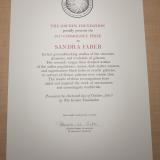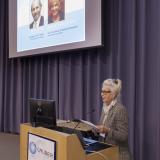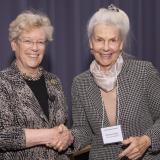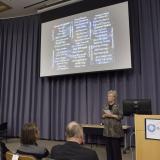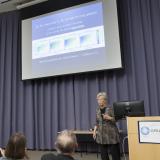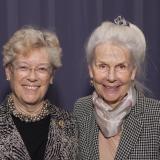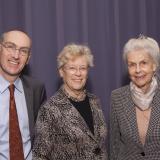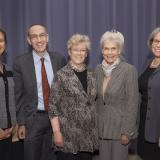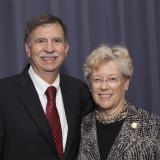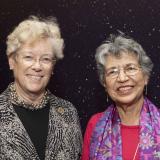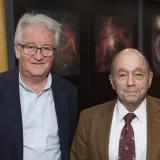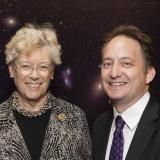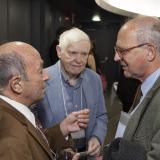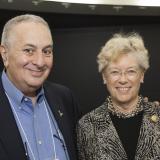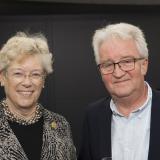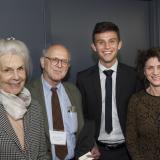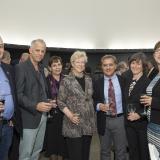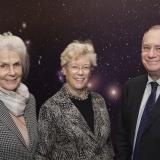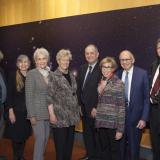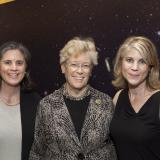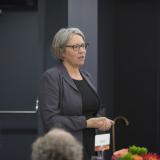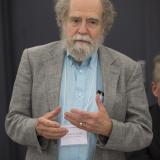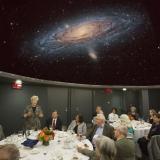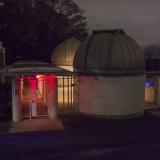2017 Gruber Cosmology Prize
2017 Cosmology Prize Recipient
Laureate Profile
The 2017 Gruber Prize in Cosmology honors Sandra M. Faber for her lifetime body of work.
Even before the start of her career, Faber had defined, albeit without realizing it, the direction her career would take. As she entered Swarthmore College, she knew she wanted to be a scientist who investigated the history of the universe, but she didn’t know whether she wanted to approach the question through the lens of the very small—subatomic physics—or the very large—astronomy. She chose the latter, but in framing the question she had inadvertently foreseen the direction that cosmology, and her career, would take: To understand the very large, you have to understand the very small.
The very small, in Faber’s case, turned out to be dark matter: the mysterious something that interacts gravitationally with ordinary matter (effects we can observe) but doesn’t emit radiation in any range of the electromagnetic spectrum (effects we can’t observe). Its inaccessibility led many astronomers to doubt its existence, at least until 1979, when Faber and John S. Gallagher produced a comprehensive review of the data, a paper soon considered a classic. Nearly all skeptics came to the conclusion that most of the matter in the universe is, indeed, “missing.”
What kind of matter it might be, however, remained open to question. Presumably it was a subatomic particle. But was it a particle that moves at nearly the speed of light—is hot, in astronomical parlance—or was it a particle that moves at a much slower rate—is cold? In 1985 Faber was part of a collaboration that produced a comprehensive theory of cold dark matter that explained in broad outline the structure and behavior of galaxies and superclusters of galaxies that populate the universe. This theory remains the paradigm underpinning all modern models of galaxy formation.
Faber’s role in that collaboration taught her a lesson she has tried to pass on to succeeding generations. Although her role was to contribute ideas on observational data, rather than theory, she was able to communicate with the theorists because she understood the physics. “I’ve always told my students that the weakness of observers is that they don’t know enough physics,” she says. “‘Go off and learn more physics,’ I tell my students. And I’ve tried to follow that rule myself.”
Faber has continued to make significant contributions to the study of galaxies, often as the Principal Investigator of increasingly larger collaborations. Among her other contributions to the field are: the relation between the orbital speeds of stars in elliptical galaxies and the galaxy’s mass (the first such relational law); the insight that a supermassive black hole lurks at the center of every large galaxy; a relationship between those central black holes and the orbital speeds of starts within the galaxies; and detection of variations in the rate of the expansion of the universe from place to place that depends on the distribution of relatively great or relatively sparse collections of mass. Since 2010 she has served as the co-Principal Investigator on the most extensive project in Hubble Space Telescope history, a survey of galaxies from the infancy of the universe.
But Faber has also distinguished herself on the technological side of the observing divide.
In the 1980s and 1990s she was a tireless advocate for the construction of the 10-meter Keck Telescope in Hawaii, the largest telescope at the time, as well as for large telescopes in general. She also had a hands-on role in the optical design for Keck and led construction of one of its biggest spectrographs. A generation has now passed during which giant telescopes have become commonplace. At the same time Faber was also contributing to the testing and commissioning of the Wide-Field Camera for the Hubble Space Telescope.
In recent years Faber has also emerged as a prolific public speaker, often addressing the topic of the relationship between cosmology and civilization. She argues that developments in cosmology over the past few decades have made us realize that our species has been given “the gift of cosmic time”—the concept that the universe exists on a scale of billions of years and that Earth will be a safe haven for our progeny for hundreds of millions of years into the future. “Astronomical knowledge tells us how we got here and furthermore, having understood that, we can extrapolate more confidently for the future.”
When she reflects on her extraordinarily fertile career, Faber recalls the “advice” her father often gave her as a child when she wasn’t doing anything in particular. “Make yourself useful, Sandra,” he would say. And so she has.
Watch Video
Citation
The Gruber Foundation proudly presents the 2017 Cosmology Prize to Sandra Faber for her groundbreaking studies of the structure, dynamics, and evolution of galaxies. Her research ranges from detailed studies of the stellar populations, masses, dark matter content, and supermassive black holes in nearby galaxies, to surveys of distant galaxies over cosmic time. The results of these investigations have aided and inspired the work of astronomers and cosmologists worldwide.



